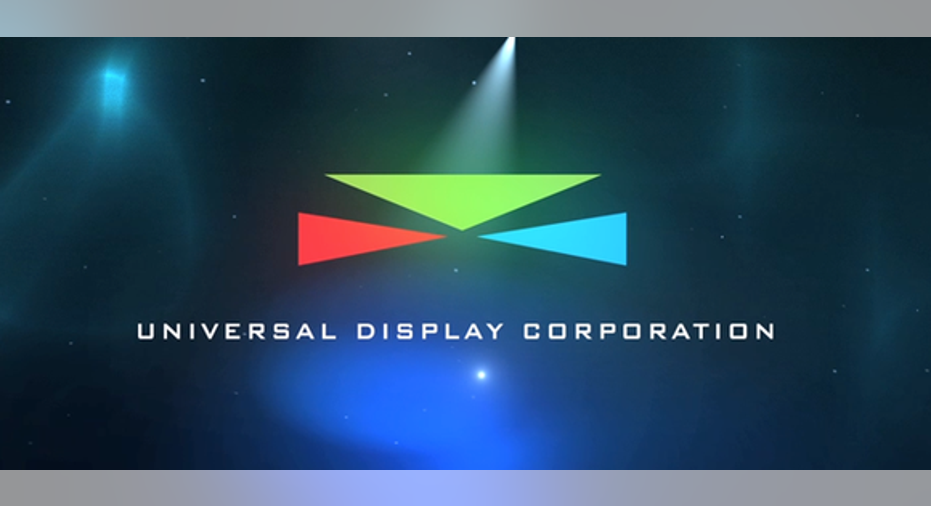Universal Display Prepares for Accelerated Growth

Universal Display Corporation(NASDAQ: OLED)released third-quarter 2016 results Thursday after the markets closed. Shares initially climbed more than 7% in Friday's early trading as a result, then settled to close up around 3% as the market digested what the OLED technologist had to say. So let's take a closer look at what drove Universal Display's business as it kicked off the second half of the year, and what to expect in the months ahead.
IMAGE SOURCE: UNIVERSAL DISPLAY CORPORATION
Universal Display's results: The raw numbers
YOY = year over year. Data source: Universal Display Corporation.
What happened with Universal Display this quarter?
- These results admittedly don't look impressive at first glance. But note that they were in line with Universal Display's expectations asoutlined last quarter. At the time, the company explained its impending ramp in revenue growth would be delayed roughly six months due to a combination of delays in the adoption of its higher-margin new emitter materials, and its customers' more efficient use and optimizing recipes ahead of their respective manufacturing capacity expansions.
- For additional perspective, and though we don't usually pay close attention to Wall Street's near-term demands, analysts' consensus estimates predicted a slightly larger third-quarter net loss of $0.04 per share.
- This quarter doesnotinclude any payments underUniversal Display's long-term patent and material-supply agreement with Samsung Display. As a reminder, Samsung's license fee this year is $75 million -- up from $60 million in 2015 -- and is recognized in two equal payments in the second and fourth quarters of each year.
- As expected, material sales declined 31.1% year over year, to $23.5 million, driven by an $8.4 million decline in emitter sales -- due to the aforementioned efficiency increases and product mix -- as well as a $2.3 million decline in host material sales.
- Royalty and license fees were flat from last year's third quarter, at roughly $5.2 million.
- Technology development and support revenue was $1.5 million, up from $0.1 million in last year's third quarter, driven by Universal Display's $33-millionacquisition of contract-research organization Adesisearlier this year.
- Generated $4.1 million in operating cash flow.
- Ended the quarter with $301.1 million in cash and equivalents (or more than $6 per share), and no debt.
- Increased headcount to over 200 employees.
- Expanded Universal Display's global footprint to include more people to support its international partners, including its recently established Chinese subsidiary, Universal Display Corporation China Limited.
- After accounting for recent new patents and last quarter's acquisition of 500 issued and pending patents from BASF, Universal Display's IP portfolio has grown to over 4,200 issued and pending patents worldwide.
What management had to say
Universal Display CFO Sidney Rosenblatt stated,
During the subsequent conference call, Rosenblatt also noted Universal Display hasn't seen any impact on its business related to Samsung's decision to permanently halt sales and production of its Galaxy Note 7 smartphone after a widely publicized botched recall of the device. The Note 7 boasted a 5.7-inch AMOLED display enabled by Universal Display's flagship technology.
In addition, Universal Display CEO Steve Abramson reminded investors that LG Display -- UDC's second-largest customer behind Samsung -- recently "reiterated its commitment to OLEDs during its third-quarter earnings call, and reaffirmed ongoing capacity plans, including in the small and mid-sized market."
More specifically, LG Display will soon accelerate its transition from LCD manufacturing to plastic OLEDs, with its expected ramp in production set to begin in the first half of next year and continue through the end of 2018.
Looking forward
With the caveat that many variables could still effect the growth of the OLED industry in these early stages, Universal Display reiterated its full-year guidance for 2016 revenue to be in the range of $190 million to $200 million.
All things considered, there weren't any big surprises in this report -- and that's a good thing. As Universal Display continues to position itself to serve the growing OLED needs of its global customer base, and as OLED continues to proliferate across smartphones, tablets,TVs, and soon, novel lighting applications, I think investors should be more than pleased with where the company stands today.
A secret billion-dollar stock opportunity The world's biggest tech company forgot to show you something, but a few Wall Street analysts and the Fool didn't miss a beat: There's a small company that's powering their brand-new gadgets and the coming revolution in technology. And we think its stock price has nearly unlimited room to run for early in-the-know investors! To be one of them, just click here.
Steve Symington owns shares of Universal Display. The Motley Fool recommends Universal Display. Try any of our Foolish newsletter services free for 30 days. We Fools may not all hold the same opinions, but we all believe that considering a diverse range of insights makes us better investors. The Motley Fool has a disclosure policy.



















